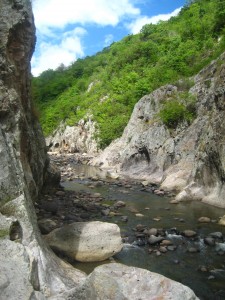 One of the highlights of my study abroad, in Nicaragua, was my trip to the Caribbean coast. It was one of the program’s planned activities, all the students and coordinators in the group travelled to the coast. We went for a long weekend so that we could have 3 days for exploring and learning about the culture in that part of the country. The people in Managua, the capital of Nicaragua, consider the Caribbean coast to be a completely different culture and experience. I agree with them because the coastal people speak a mix of English and Creole and have different traditions and festivals. The journey, the people we met, and the landscape all made this experience one of the most memorable of my time in the country.
One of the highlights of my study abroad, in Nicaragua, was my trip to the Caribbean coast. It was one of the program’s planned activities, all the students and coordinators in the group travelled to the coast. We went for a long weekend so that we could have 3 days for exploring and learning about the culture in that part of the country. The people in Managua, the capital of Nicaragua, consider the Caribbean coast to be a completely different culture and experience. I agree with them because the coastal people speak a mix of English and Creole and have different traditions and festivals. The journey, the people we met, and the landscape all made this experience one of the most memorable of my time in the country.
The journey, to the coast, began with a 10-hour bus ride from the capital, continued through the middle of the country to Rama, a port on the river. We caught a panga, which is the Spanish term used for the local boat, to Bluefields, the capital of RAAN. The bus ride was an overnighter that took us up into the mountains and then back down to the lowlands of the eastern part of the country. During the bus ride the student cohort bonded and grew closer, and we also met new people. We arrived at Rama at one o’clock in the morning and waited until sunrise to catch the panga, because they do not drive the boats during the night. The panga ride was the first of many panga rides that we took during our trip in the Caribbean. That ride took us down the river through plantain plantations, towns, and beautiful forests that demonstrated the beauty of Nicaragua. The ride ended in Bluefields, where we then took another panga ride to Pearl Lagoon a town where a mixquito tribe was located. We stayed with the leader of the tribe for a night and he told us the history of his people.
Pearl Lagoon was a gorgeous area that is a protected turtle habitat. The spot is surrounded by palm trees and mangroves, which help protect the area from hurricanes. After our time in the town, we took yet another panga to Bluefields, where we caught a plane to Big Corn Island for the next leg of our journey. We had to go to Big Corn Island so that we could take a panga to Little Corn Island, where we spent the next 2 days exploring and doing activities. The panga ride to Little Corn Island was one of the most exciting experiences that I had in Nicaragua, because we crossed the Caribbean at night in a boat similar to a motorboat. Water was splashing all over us and waves were crashing as well, as we motored across the channel to Little Corn Island. By the time we touched down on a beach, we were soaked and exhausted from holding on to the boat, and from the amount of laughing we shared during the ride. On the island, we went snorkeling, visited the priest of the island, and tasted the amazing cuisine that is traditional to the Caribbean coast. Local fare includes, lobster, gallo pinto, which is a mixture of rice and beans with coconut milk, and other seafood preparations. The people of the coast were all really welcoming and willing to tell us the history of their people and to  show us the beauty of their culture.
show us the beauty of their culture.
This trip was an experience that I will remember forever. It gave me the pleasure of learning about another culture and seeing the traditions from an insider’s perspective. The bonds that I forged with my fellow companions are, in my opinion, lifelong because they grew from phenomenal experiences. I am so glad that I took the time to study abroad and allowed myself the opportunity to participate in another culture. I have already applied the knowledge that I gained from these experiences to my classes, my family, and my friends. I enthusiastically tell everyone I know the importance of a study abroad experience.
– Emma Burns, Nicaragua